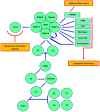Components of the Lectin Pathway of Complement in Solid Tumour Cancers
- PMID: 35326694
- PMCID: PMC8946279
- DOI: 10.3390/cancers14061543
Components of the Lectin Pathway of Complement in Solid Tumour Cancers
Abstract
The complement system is an important branch of the humoral innate immune response that can be activated via three distinct pathways (classical, alternative, lectin), contributing to keeping/restoring homeostasis. It can also interact with cellular innate immunity and with components of acquired immunity. Cross-talk between the complement system and other enzyme-dependent cascades makes it a more influential defence system, but on the other hand, over- or chronic activation can be harmful. This short review is focused on the dual role of the lectin pathway of complement activation in human solid tumour cancers, including those of the female reproductive system, lung, and alimentary tract, with emphasis on the aforementioned cross-talk.
Keywords: MBL-associated serine protease (MASP); cancer; collectin; complement; ficolin; lectin pathway.
Conflict of interest statement
The authors declare no conflict of interest.
Figures


Similar articles
-
A journey through the lectin pathway of complement-MBL and beyond.Immunol Rev. 2016 Nov;274(1):74-97. doi: 10.1111/imr.12468. Immunol Rev. 2016. PMID: 27782323 Review.
-
Structural and functional overview of the lectin complement pathway: its molecular basis and physiological implication.Arch Immunol Ther Exp (Warsz). 2013 Aug;61(4):273-83. doi: 10.1007/s00005-013-0229-y. Epub 2013 Apr 7. Arch Immunol Ther Exp (Warsz). 2013. PMID: 23563865 Review.
-
The lectin pathway of complement and rheumatic heart disease.Front Pediatr. 2015 Jan 21;2:148. doi: 10.3389/fped.2014.00148. eCollection 2014. Front Pediatr. 2015. PMID: 25654073 Free PMC article. Review.
-
Collectin-11/MASP complex formation triggers activation of the lectin complement pathway--the fifth lectin pathway initiation complex.J Innate Immun. 2013;5(3):242-50. doi: 10.1159/000345356. Epub 2012 Dec 4. J Innate Immun. 2013. PMID: 23220946 Free PMC article.
-
A novel measurement method for activation of the lectin complement pathway via both mannose-binding lectin (MBL) and L-ficolin.J Immunol Methods. 2009 Sep 30;349(1-2):9-17. doi: 10.1016/j.jim.2009.08.005. Epub 2009 Aug 20. J Immunol Methods. 2009. PMID: 19699205
Cited by
-
Pre-treatment inflammatory and immune system parameters predicting cervical cancer metastasis.Turk J Obstet Gynecol. 2023 Dec 8;20(4):285-292. doi: 10.4274/tjod.galenos.2023.80912. Turk J Obstet Gynecol. 2023. PMID: 38073222 Free PMC article.
-
Decreased complement 4d increases poor prognosis in patients with non-small cell lung cancer combined with gastrointestinal lymph node metastasis.Exp Ther Med. 2022 Jul 5;24(3):560. doi: 10.3892/etm.2022.11497. eCollection 2022 Sep. Exp Ther Med. 2022. PMID: 35978919 Free PMC article.
-
Detrimental interactions of hypoxia and complement MASP-1 in endothelial cells as a model for atherosclerosis-related diseases.Sci Rep. 2024 Jun 27;14(1):14882. doi: 10.1038/s41598-024-64479-6. Sci Rep. 2024. PMID: 38937560 Free PMC article.
-
Inflammatory Processes in Alzheimer's Disease-Pathomechanism, Diagnosis and Treatment: A Review.Int J Mol Sci. 2023 Mar 30;24(7):6518. doi: 10.3390/ijms24076518. Int J Mol Sci. 2023. PMID: 37047492 Free PMC article. Review.
-
Ficolin-3 Activates Complement and Triggers Necroptosis in Cholangiocarcinoma Cells via the RIPK1/RIPK3/MLKL Signaling Pathway.FASEB J. 2025 May 31;39(10):e70673. doi: 10.1096/fj.202403313R. FASEB J. 2025. PMID: 40407231 Free PMC article.
References
Publication types
LinkOut - more resources
Full Text Sources
Miscellaneous

